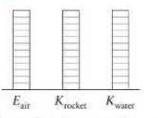In the toy water-rocket of Problem 64, the pressurized air can store internal energy. Assume you have
Question:
In the toy water-rocket of Problem 64, the pressurized air can store internal energy. Assume you have a rocket that expels water at a speed of \(15.0 \mathrm{~m} / \mathrm{s}\) and the opening through which the water leaves is \(10.0 \mathrm{~mm}\) in diameter.
(a) Using Figure P5.72 as a template, sketch energy bar graphs for three instants: when the rocket is fully pressurized but has not been launched, after the launch when half the water has been expelled, and after all the water has been expelled. ( \(b\) ) What is the approximate inertia of the water expelled in the first second of flight?
(c) Does the rocket accelerate at a constant rate?
Data from Problem 64
A toy water-rocket consists of an elongated plastic tank with a nozzle at one end (Figure P5.64). A hand pump is used to get pressurized air into the tank. If there is nothing but air in the tank, the performance is lackluster. If some water is put in the tank before it is pumped up with air, however, the flight is dramatically better. Why?
Data from Figure P5.72

Step by Step Answer:





